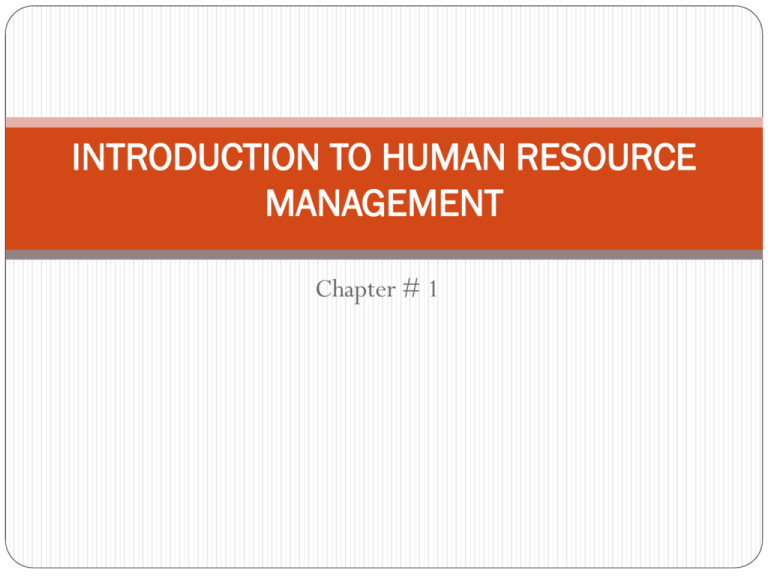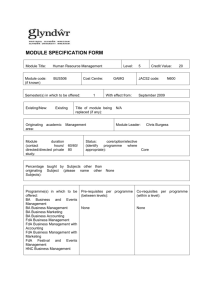
INTRODUCTION TO HUMAN RESOURCE
MANAGEMENT
Chapter # 1
What is HRM?
Management process
The five basic functions of planning, organizing, staffing,
leading, and controlling.
Human resource management (HRM)
The policies and practices involved in carrying out the “people”
or human resource aspects of a management position, including
recruiting, screening, training, rewarding, and appraising.
1–2
© 2005 Prentice Hall Inc. All rights reserved.
Personnel Aspects Of A Manager’s Job
Conducting job analyses (determining the nature of each employee’s job)
Planning labor needs and recruiting job candidates
Selecting job candidates
Orienting and training new employees
Managing wages and salaries (compensating employees)
Providing incentives and benefits
Appraising performance
Communicating (interviewing, counseling, disciplining)
Training and developing managers
Building employee commitment
1–3
© 2005 Prentice Hall Inc. All rights reserved.
Why is HRM important
Hire the wrong person for the job
Experience high turnover
Have your people not doing their best
Waste time with useless interviews
Have your company in court because of discriminatory actions
Have your company cited by OSHA for unsafe practices
Have some employees think their salaries are unfair and inequitable relative to
others in the organization
Allow a lack of training to undermine your department’s effectiveness
Commit any unfair labor practices
1–4
© 2005 Prentice Hall Inc.
All rights reserved.
Basic HR Concept
Getting results
The bottom line of managing
HR creates value by engaging
in activities that produce
the employee behaviors
the company needs to
achieve its strategic
goals.
1–5
© 2005 Prentice Hall Inc. All rights reserved.
Line and Staff Aspects of HRM
Line manager
A manager who is authorized to direct the work of subordinates
and is responsible for accomplishing the organization’s tasks.
Staff manager
A manager who assists and advises line managers.
1–6
© 2005 Prentice Hall Inc. All rights reserved.
Line Managers’ HRM Responsibilities
1.
Placing the right person on the right job
2.
Starting new employees in the organization (orientation)
3.
Training employees for jobs new to them
4.
Improving the job performance of each person
5.
Gaining creative cooperation and developing smooth working relationships
6.
Interpreting the firm’s policies and procedures
7.
Controlling labor costs
8.
Developing the abilities of each person
9.
Creating and maintaining department morale
10. Protecting employees’ health and physical condition
1–7
© 2005 Prentice Hall Inc. All rights reserved.
HR and Authority
Authority
The right to make decisions, direct others’ work, and give
orders.
Staff authority
Advisory relationship
Innovator role
Employee advocacy role
Line authority
Supervisor-subordinate relationship
Functional authority
Authority as coordinator of personnel
1–8
© 2005 Prentice Hall Inc. All rights reserved.
Functions of the HR Manager
A line function
The HR manager directs the activities of the people in his or
her own department and in related service areas (like the plant
cafeteria).
A coordinative function
HR managers also coordinate personnel activities, a duty often
referred to as functional control.
Staff (assist and advise) functions
Assisting and advising line managers is the heart of the HR
manager’s job.
1–9
© 2005 Prentice Hall Inc. All rights reserved.
Examples of HR Job Duties
Recruiters
Search for qualified job applicants.
Equal employment opportunity (EEO) coordinators
Investigate and resolve EEO grievances, examine organizational
practices for potential violations, and compile and submit EEO
reports.
Job analysts
Collect and examine information about jobs to prepare job
descriptions.
1–10
© 2005 Prentice Hall Inc. All rights reserved.
Examples of HR Job Duties (cont’d)
Compensation managers
Develop compensation plans and handle the employee benefits
program.
Training specialists
Plan, organize, and direct training activities.
Labor relations specialists
Advise management on all aspects of union–management
relations.
1–11
© 2005 Prentice Hall Inc. All rights reserved.
HR Department Organizational Chart (Large Company)
1–12
Source:
from BNA Bulletin
to Management,
June 29, 2000.
© Adapted
2005 Prentice
Hall
Inc. All rights
reserved.
Figure 1–1
Approaches to organize HR
Transactional HR
Carrying day to day transactions
Corporate HR
Helping top management
Embedded HR
Helps departments like sales
Centers of expertise HR
Specialized consulting within companies
1–13
© 2005 Prentice Hall Inc. All rights reserved.
Cooperative Line and Staff HR
Management
1–14
1.
The line manager’s responsibility is to specify the qualifications
employees need to fill specific positions.
2.
HR staff then develops sources of qualified applicants and
conduct initial screening interviews
3.
HR administers the appropriate tests and refers the best
applicants to the supervisor (line manager), who interviews and
selects the ones he or she wants.
© 2005 Prentice Hall Inc. All rights reserved.
HR Organizational Chart (Small Company)
1–15
© 2005 Prentice Hall Inc. All rights reserved.
Figure 1–2
Employment and Recruiting—Who Handles It? (percentage of all
employers)
Note: length of bars represents prevalence of activity among all surveyed employers.
1–16
Source:
HR Department
Benchmarks
Analysis,”
BNA/Society
for Human Resource Management, 2002.
© 2005
Prentice
Halland
Inc.
All rights
reserved.
Figure 1–3
The Changing Environment Of
HR Management
HR’s changing role:
Took over hiring and firing from supervisors, payroll, and
benefit plans administration.
Protecting the firm in its interaction with unions(labor
relations).
Assumed organizational responsibilities for equal employment
and affirmative action.
1–17
© 2005 Prentice Hall Inc. All rights reserved.
TRENDS SHAPING HRM
Globalization
Sales, ownership, manufacturing in new markets
More pressure
Lower cost
Less secure jobs (off shoring)
Partnerships
1–18
© 2005 Prentice Hall Inc. All rights reserved.
TRENDS SHAPING HRM cont.
Indebtedness (leverage)
Spending more and earning less
Technological trends
PDAs to communicate
Telecommuting
Virtual on line communities
1–19
© 2005 Prentice Hall Inc. All rights reserved.
TRENDS SHAPING HRM cont.
Trends in nature of work
High tech jobs
Service jobs
Knowledge work and human capital
Workforce and demographic trends
1–20
Demographic trends
Nontraditional workers
Retirees
Generation Y
© 2005 Prentice Hall Inc. All rights reserved.
TRENDS SHAPING HRM cont.
Economic challenges and trends
Boom
Recession
1–21
© 2005 Prentice Hall Inc. All rights reserved.
Employment Exodus:
Projected Loss of Jobs and Wages
1–22
Source:
“States
FightInc.
Exodus
of Jobs,”
Wallreserved.
Street Journal, June 3, 2003, p. 84.
© Michael
2005 Shroeder,
Prentice
Hall
All
rights
Figure 1–4
TRENDS In HRM
The new HR manager
Focus on big picture issues
New ways to provide transactional services
Have new proficiencies
The Need to “Know Employment Law”
Equal employment laws
Occupational safety and health laws
Labor laws
1–23
© 2005 Prentice Hall Inc. All rights reserved.
TRENDS In HRM cont.
High performance work systems
Generate more job applicants
Screen candidates more effectively
Provide more and better training
Link pay more explicitly to performance
Provide a safer work environment
Produce more qualified applicants per position
More employees are hired based on validated selection tests
Provide more hours of training for new employees
Higher percentages of employees receiving regular
performance appraisals.
1–24
© 2005 Prentice Hall Inc. All rights reserved.
TRENDS In HRM cont.
Strategic HRM
Evidence based HRM
HR Professional Certification
HR is becoming more professionalized.
Managing ethics
Discrimination
Harassment
Glass ceiling
Employee surveillance
Employee safety
1–25
© 2005 Prentice Hall Inc. All rights reserved.
Effects CFOs Believe Human Capital
Has on Business Outcomes
1–26
Source:
Bates, “Business
Partners,”
HR Magazine,
2003, p. 49
© Steven
2005H.Prentice
Hall
Inc. All
rights September
reserved.
Figure 1–6
Measuring HR contributions
1–27
Strategy
The
company’s long-term plan for how it will balance its
internal strengths and weaknesses with its external
opportunities and threats to maintain a competitive
advantage.
HR
managers today are more involved in partnering with
their top managers in both designing and implementing their
companies’ strategies.
Top
management wants to see, precisely, how the HR
manager’s plans will make the company more valuable.
1–27
© 2005 Prentice
All rights
© Hall
2005Inc.
Prentice
Hallreserved.
Inc. All rights reserved.
Strategy and the Basic HR Process
1–28
© 2005 Prentice Hall Inc. All rights reserved.
Figure 1–8








